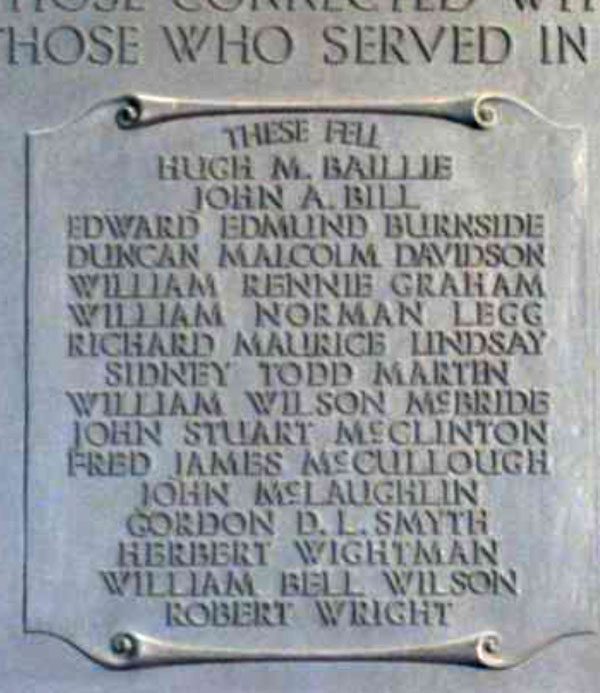| Gordon Dill Long Smyth was the youngest son of the Rev James Smyth and Mary Frances Smyth. James Smyth and Mary Long were married on 15th December 1874 in the district of Coleraine
|
| Gordon Smyth was born on 10th March 1896 in Coleraine, County Londonderry. He was the youngest of eleven children, all born in the Coleraine area.
|
| Gordon's father was a Presbyterian minister in Crossgar, County Londonderry.
|
| Known family: James Smyth, Mary Frances Smyth, Lizzie Smyth (born 15th September 1875), Samuel Andrew Smyth (born about 1877), James Smyth (born 26th February 1879), William Smyth (born 1st May 1881), Isabella Sarah Smyth (born 16th October 1886), Mary F D Smyth (born 18th November 1888), Wilhelmina Rebecca Smyth (born rd November 1890), John Smyth (born 27th January 1893), Margaret Madge Smyth (born 2nd November 1894), Gordon Dill Smyth (born 10th March 1896).
|
| The 1901 census records Gordon Dill Smyth as age 4 living at house 18 in Dromore, Drumcroon, County Londonderry. Oddly, neither parent is listed. Gordon's oldest brother, Samuel Andrew, age 24, was a Probationer in the Indian Civil Service and seemed to be in charge.
|
| Rev. James Smyth retired in 1903 due to ill health.
|
| Like his brother before him, Gordon Smyth was a boarder at the Royal School Dungannon, attending from 1910, The 1911 census list him as such.
|
| The 1911 census did not list George as living at house 16 in Dromore, Drumcroon, Londonderry with the family.
|
| The headmaster of the Royal School Dungannon was Robert Foster Dill, who was related to Smyth family.
|
| When Robert left the school for a post at Foyle College, Gordon followed him.
|
| Gordon was then educated at the Royal Belfast Academical Institution, the RBAI.
|
| In 1913, Rev. James Smyth died.
|
| On 15th October 1914, Gordon Smyth entered Queens University to undertake a degree in medicine. On 2nd November 1914, Gordon entered the Officer Training Corps at Queens.
|

|

|
| Gordon Smyth received his commission in January 1916 and was transferred from the 20th Battalion to the 13th Battalion of the Royal Irish Rifles on 20th June 1916.
|
| 2nd Lieutenant Gordon Smyth was serving with the 13th Battalion of the Royal Irish Rifles when he was killed in action during the battle of Langemarck on 16th August 1917.
|
| From the Belfast Newsletter dated 24th August 1917:
|

|
| Second Lieutenant Gordon Dill L Smyth, Royal Irish Rifles, killed in action on the 16th August, was a son of the late Rev James Smyth, B.A., Crossgar, County Down and Mrs Smyth, University Street, Belfast. He received his early education at the Royal School Dungannon; Foyle College, Londonderry; and the Royal Belfast Academical Institution, and was a second year medical student in Queens University when he obtained his commission in January 1916. He went to France in June 1916.
|
| From the Tyrone Courier and News dated Thursday 30 August 1917:
|

|
| Second Lieutenant Gordon Dill L Smyth, Royal Irish Rifles, who was killed in action on the 16th August 1917, received his early education at the Royal School Dungannon. He was a son of the late Rev James Smyth, B.A., Crossgar, County Down
|
| 2nd Lieutenant Gordon Smyth has no known grave and is commemorated on the Tyne Cot Memorial near Ypres in Belgium.
|
| 2nd Lieutenant Gordon Smyth is also commemorated on the Royal Belfast Academical Institution War Memorial.
|
| 2nd Lieutenant Gordon Smyth is also commemorated on the Fitzroy Presbyterian Church War Memorial.
|

|
| The CWGC record 2nd Lieutenant Gordon Dill Long Smyth as the son of and the Rev James Smyth and Mrs M F D Smyth of 111 University Street Belfast.
|
| Many thanks to Paul Kerr and the Royal School Dungannon for his research and all the information provided.
|

|
